 The Animals of True Blue Animal Rescue would like to thank Daniel Gaskamp (center) for sharing his birthday with the animals by asking for donations of food for the animals for his birthday. Thanks to his generosity the animals will be well fed for quite a while! Daniel and Teresa Gaskamp are a blessing to TBAR and all the animals. Love this picture of them with their children during Daniels party.
The Animals of True Blue Animal Rescue would like to thank Daniel Gaskamp (center) for sharing his birthday with the animals by asking for donations of food for the animals for his birthday. Thanks to his generosity the animals will be well fed for quite a while! Daniel and Teresa Gaskamp are a blessing to TBAR and all the animals. Love this picture of them with their children during Daniels party.
Category Archives: Blog
Your Death & Protecting Pets: Why A Trust Is Better Than A Will
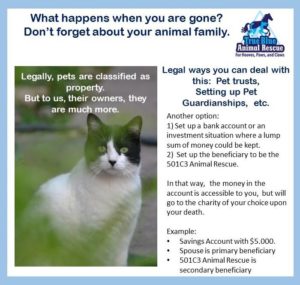 As animal lovers, we all want to care and protect our pets from any kind of possible harm, but when it comes to our own ultimate demise, we may think that including them in our will is what’s best for them. Often when we leave them for a short periods of time and they may become anxious about our departure, but being gone from them permanently without our love and support is a valid concern for many pet owners.
As animal lovers, we all want to care and protect our pets from any kind of possible harm, but when it comes to our own ultimate demise, we may think that including them in our will is what’s best for them. Often when we leave them for a short periods of time and they may become anxious about our departure, but being gone from them permanently without our love and support is a valid concern for many pet owners.
At first we may believe that including them in our will would be enough to take care of them after our departure, but legal experts beg to differ. A blanket amount left to look after in a last will and testament is loving, generous and giving, but it doesn’t include their day-to-day needs and the unknown future of your four-legged best friend. Let’s look at some ways why a trust is much better for them (and you) in the long run:
The Big Three
According to the Bar Association, there are three options when it comes to protecting your pet after your departure. They include your will, a legal trust fund being put into place or a verbal agreement. For the sake of argument, an agreement with a friend, family member or other person is a definite possibility, but it still won’t stand up in a legal courtroom. So for legal purposes, we’ll concentrate on the differences between a will and a trust.
I Hereby Do Bequeath
When it comes to the letter of the law, pets are considered as property and not an actual member of our family. Therefore, loopholes exist with their protection and care under the legal guidelines and enforceable parts of a will. In other words, as a “piece of property,” you can bequeath an animal to a friend or family member, but it doesn’t guarantee their protection, care, feeding and other important parts of their life.
For example, if the party of the first part (which is you), leaves the “possession” of a pet to a sibling, friend or family member, this only means that they now own them, and have no responsibilities for their care or protection. There are no legal requirements in place that they are fed, walked, taken care of – they can even be taken to a shelter or sold without your permission.
Trust In The Law
In comparison to a statement made in a will, unlike a simple directive or order of possession, a trust can command certain requirements that include:
Payment amounts that are set into place to provide for their continued care, feeding, exercise, medical needs, without regard for ownership.
Agreements are set into place that manage a pet’s health, maintenance and welfare including veterinary visits, grooming and other needs
Financial trustees can be put into place to manage assets when it comes to future finances and growth of their existing funds that were put into place for their protection
Trusts and pet agreements that are made in these legal documents also make provisions should you become incapacitated and unable to care for your companion animal. They will even ensure that your beloved best friend stays with you if you have medical issues that leave you bedridden at home for extended periods of time.
The Grey Law
In closing, if you think about the story of Greyfriars Bobby, a little dog that belonged to an entire town, rather than a single person. After the demise of his owner, a “Bobby” or policeman, protecting and patrolling the streets of Edinburgh in England, the citizens of this small town banded together to protect this little canine from being destroyed due to a lack of ownership.
According to the tale, little “Bobby,” refused to leave his master’s side following this policeman’s untimely death and slept on his grave every night for over a decade. But during the interim, a law was passed that every dog must be licensed by an owner and since Bobby had none, the love of the local townspeople paid his fee and made them a part of their city.
This is a perfect example of how a legal precedence landed this little pooch into a safety net which was then protected by laws that stated he wasn’t a stray. Instead, he was legally protected as a member of their society and community who were enlisted to care for him under the law. You can invoke this kind of trust when it comes to the care of your beloved pet.
2016 Halloween Tips
10 Tip Series on Halloween Pet Safety
- Trick-or-treat candies are not for pets. All forms of chocolate – especially baking or dark chocolate – can be dangerous, even lethal, for dogs and cats
- Bring your pet in the house on Halloween: surprisingly, vicious pranksters have been known to tease, injure, steal, or even kill pets on Halloween night. Inexcusable? Yes! But preventable nonetheless.
- Keep pets confined and away from the door. Not only will your door be constantly opening and closing on Halloween, but strangers will be dressed in unusual costumes and yelling loudly for their candy. Putting your dog or cat in a secure room away from the front door will also prevent them from darting outside into the night… a night when no one wants to be searching for a lost loved one.
- Keep your outdoor cats inside several days before and several days after Halloween. Black cats are especially at risk from pranks or other cruelty-related incidents. In fact, many shelters do not adopt out black cats during the month of October as a safety precaution.
- Keep Halloween plants such as pumpkins and corn out of reach. Although they are relatively nontoxic, such plants can induce gastrointestinal upset should your pets ingest them in large quantities. Intestinal blockage can even occur if large pieces are swallowed.
- Don’t keep lit pumpkins around pets. Should they get too close, they run the risk of burning themselves or knocking it over and causing a fire.
- Keep wires and electric light cords out of reach. If chewed, your pet could cut himself or herself on shards of glass or plastic, or receive a possibly life-threatening electrical shock.
- Don’t dress your pet in a costume unless you know they’ll love it. If you do decide that Fido or Kitty needs a costume, make sure it isn’t annoying or unsafe. It should not constrict movement, hearing, or the ability to breathe or bark and meow.
- Try on pet costumes before the big night. If they seem distressed, allergic, or show abnormal behavior, consider letting them go in their “birthday suit”. Festival bandanas usually work for party poopers, too.
- IDs, please! If your dog or cat should escape and become lost, having the proper identification will increase the chances that they will be returned. Just make sure the information is up-to-date, even inf your pet does have one of those fancy-schmancy embedded microchips.
Everyone at TBAR wishes you and your pets a safe and happy Halloween!
Rover.com Real-life Heroes: Animal Rescue Volunteers Share How They Keep Fighting the Good Fight
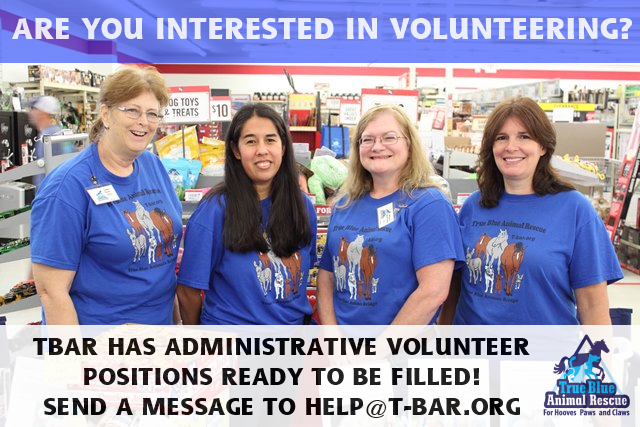
Here is a great article from Rover.com that talks about the challenges animal rescues face, featuring some of our volunteers!
11 Questions to Ask Your Future Pet Sitter
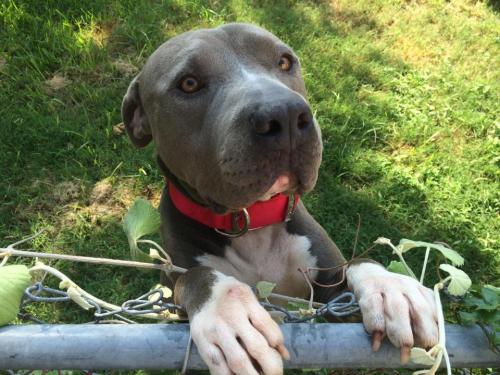 When parents hire a babysitter, they normally spend their time getting to know the individual who will take care of their children. This is no different from hiring a pet sitter.
When parents hire a babysitter, they normally spend their time getting to know the individual who will take care of their children. This is no different from hiring a pet sitter.
If you’re thinking about hiring a new pet sitter, don’t just pick the first one you see on a Google result. Instead, you’re going to want to ask a handful of questions first to make sure you’re making the best choice.
1. What do you like about pet sitting?
This is an important question which is often overlooked. Ask your pet sitter why he or she went into the business. A good pet sitter will often tell you they do it because of their love for animals, not the money.
2. What’s your experience?
Pets are quite unpredictable in several ways. However, when you have an experienced pet care provider, it means you are going to have a peace of mind since they will know how to deal with all sorts of situations.
3. Can my pet meet you first?
Before even hiring a pet sitter, see how the potential pet sitter relates with the pet. Even with all the training in the world, it will not matter if the pet does not get along with the pet sitter you are interviewing. Occasionally, pets have an immediate negative reaction to an individual or the pet may just want to warm up to a stranger first. Most of the time you won’t have to ask this as most reputable pet sitters will want to meet your pets before you pay the bill.
4. How frequently can you walk my dog?
Make sure your pet sitter is able to take the dog on the walks for the time and length they are used to. Sticking to a schedule is going to help your pet feel less anxious and happier when you get home.
5. Are there going to be other dogs around?
If your pet gets along with others, that’s fine; however if not, it may pose a problem. You will want to ensure the pet sitter is not walking 6 dogs at once or bringing other pets to your home while working, for example. It’s vital that your pet sitter provides your pet the full attention he or she deserves.
6. Can you take care of my dog’s special needs?
When your pet requires everyday medication or freshly prepared food, make sure you let your future pet sitter know about this up front. There might be an additional charge, depending on the circumstances. A good pet sitter will know to ask this before you even think about it.
7. What’s the amount of time you are able to spend with my dog?
Take this time to find out the amount of time your future pet sitter is going to be able to spend with your pet. Dogs and even cats like routines, and sticking to this as much as possible is going to lead to best experience for everyone. Most pet sitters will hang out with your pet for about 30 minutes.
8. Are you able to handle an emergency?
If something were to happen to your pet while you were away, see what the pet sitter’s course of action would be. Do they contact your vet? How do they pay for an emergency procedure? Would they have time for an emergency?
9. Are you insured?
All pet sitters should be bonded and insured to cover expensive accidents or damages. Even if they say yes, be sure that they show the insurance and any necessary paperwork to prove it.
10. Do you have a list of references?
You want to know about your pet sitter, don’t you? The best place you can gather information is through references. Reputable pet sitters will be more than happy to offer email addresses and phone number of their current clients.
11. How can I reach you if I want to check in on my dog?
While you are away, you probably want to know how your dog is doing. It can be quite frustrating if you are unable to communicate with your pet sitter. Ask if it’s easier to respond to an email, a quick call or text message. Also ask how he or she will keep you updated. Will they send daily emails? A text message? Frequent updates are a great way to know your pet sitter showed up and took care of your pet.
Is Your Dog Overheated or at Risk From Dehydration?
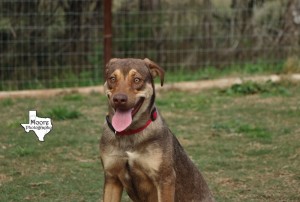
Photo of Opal by Moore Photography
Texas is well known for it’s heat and humidity so keeping our canines cool can be challenging. During the “dog days of summer,” some canines can suffer from dehydration, becoming overheated and suffer from possible heat exhaustion. It’s important for pet owners to understand when their dogs may be at risk and what they should look for in the way of signs and symptoms.
Sometimes we may not notice if our dog is simply being lazy or if them being lethargic (a huge red flag) is heat-related. If your dog is normally excited to see you when you get home from work or school, they’re less than enthused when it’s time to go for a walk, there could be a problem.
Some dogs are at a higher risk
Older dogs and younger pets are at a greater risk of developing heat-related problems along with dogs who may be overweight or obese. Canines with black hair or skin, and dogs like pugs (known as Brachycephalic breeds) who have shorter snouts are often victims of breathing disorders that can be elevated in the heat. If you notice your dog is having difficulty breathing when it’s hot, you should take them to see a veterinarian immediately.
The dangers of dehydration and heat stroke in dogs
When it comes to dehydration, there’s one quick and easy test that humans can perform on dogs to quickly see if their lacking in fluids. Using your thumb and forefinger, gently pinch a small amount of skin on a dog’s back and after releasing, it should pop back into place almost immediately. If not, this lack of elasticity is a sign they’re in trouble and should be taken to the vet.
Some symptoms of possible dehydration can mimic those of heat stroke, so we should pay attention to any of these warning signs your dog could be in danger, including:
- seeking cooler places to lie down
- lying down and is difficult to rouse
- behaving confused, disorientated, weak and/or lethargic
- showing a lack of coordination
- panting persistently, which could start, stop and begin again
- expressing restlessness, agitation or aggression for no apparent reason
- whining or barking for no reason
- foaming or frothing at the mouth
- drooling excessively (known as hypersalivation)
- breathing in a way that is labored or difficult
- having an increased heart rate
- developing dry, white or red and tacky gums
- vomiting or diarrhea
Signs of dehydration in dogs that weren’t listed above can often include:
- a loss of appetite
- rapid weight loss
- depression
- excessive urination, which means water isn’t being absorbed properly
- sunken eyes
Dogs who are housed outdoors can be prone to drink less since their water can become too hot and canines who are outside during winter can have their water bowls freeze without their owner’s knowledge. Anything that adversely affects a dog’s appetite or water intake can predispose a dog to possible dehydration.
If left untreated, these types of symptoms can lead to seizures, collapse, coma or even death in some cases. Remember that it doesn’t necessarily have to be hot for a dog to become overheated or dehydrated. While it’s obviously more prevalent during summer months, we should still monitor their behaviors and actions for signs of heat stroke or dehydration year round.
Swimming Safety
Practice Safe Swimming with your family and pets !
Tip 1: While under supervision, teach young dogs and dogs new to the pool where the steps are. Make sure they always exit at the steps so they will remember where to go if they fall in.
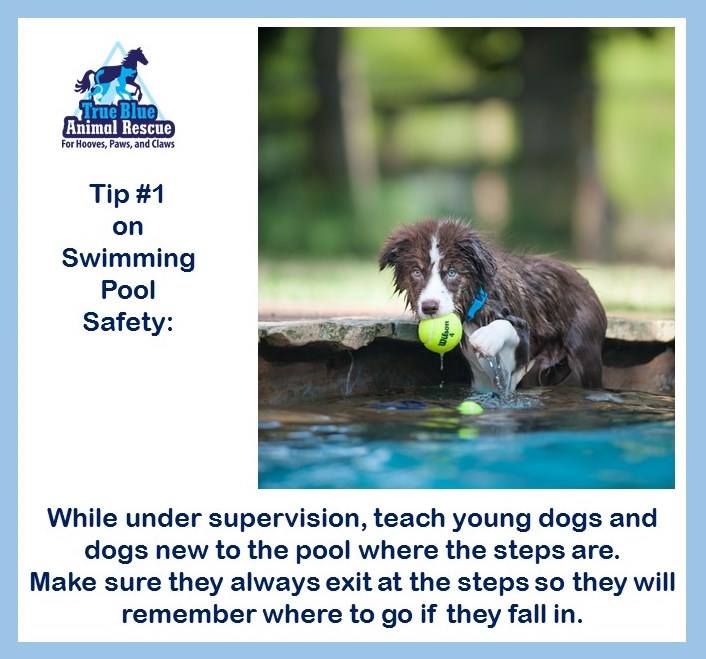
Tip 2: Even dogs who love the water often need to be forced to take a break. Always be on the lookout for signs of fatigue.
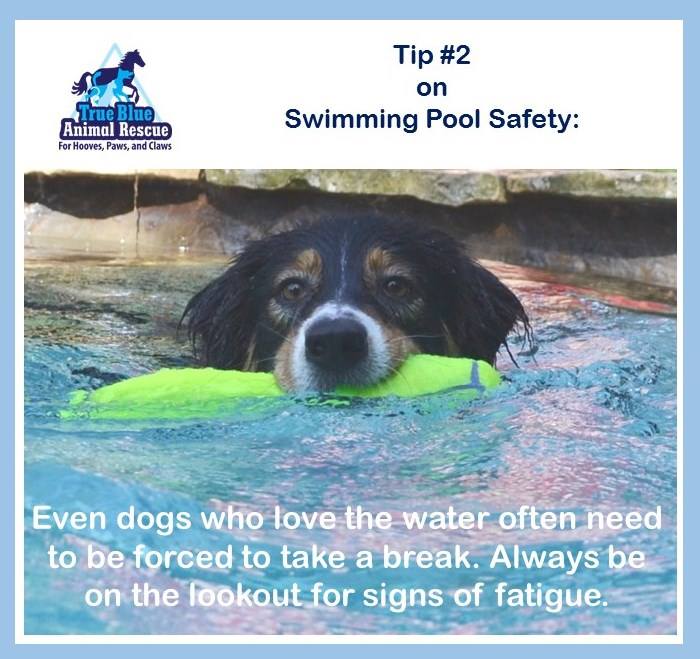
Tip 3: Not all dogs can swim. Older dogs, heavy dogs, or certain breeds of dogs just don’t get the hang of it immediately. Test your dog in a controlled environment. For these dogs, the safest course of action may be a doggie life vest.
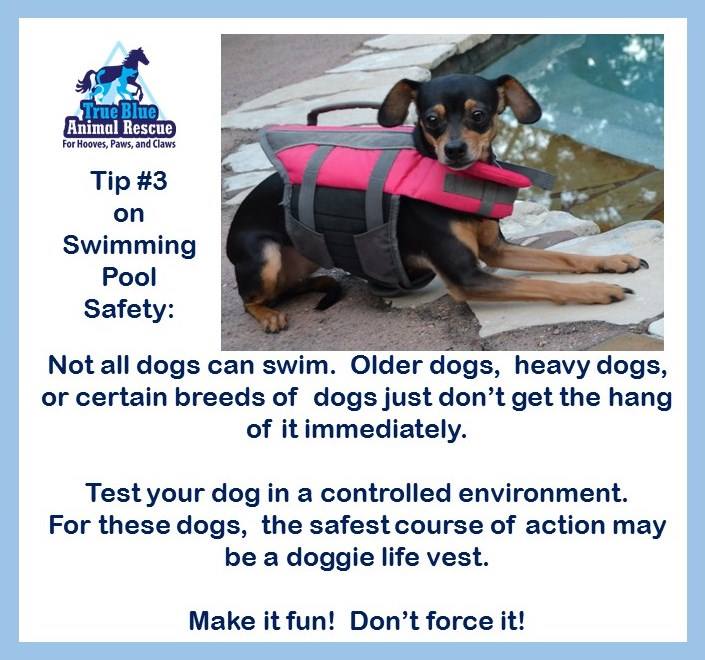
Bonus! Sunglasses Day!
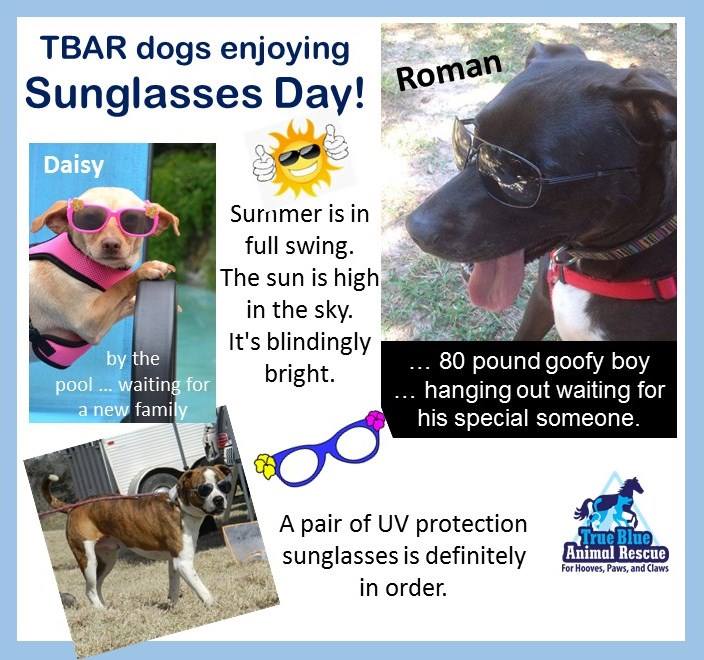
What happens to your pets when you are gone?
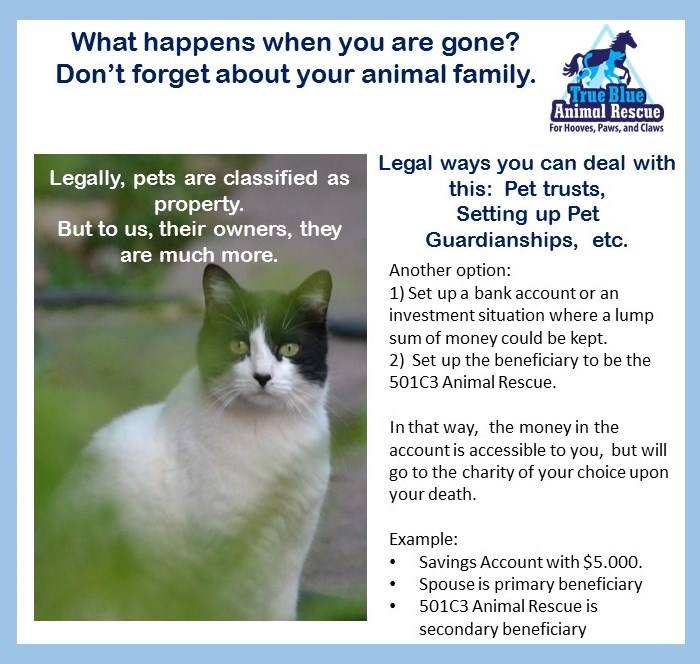
What happens when you are gone? Don’t forget about your animal family. Legally, pets are classified as property. But to us, their owners, they are much more.
Legal ways you can deal with this issue is setting up pet trust or guardianship. Another way is to set up a bank account or an investment situation where a lump sum of money could be kept, or set up the beneficiary to be the 501(c)3 animal rescue. In that way, the money in the account is accessible to you, but will go to the charity of your choice upon your death.
Another way to deal with your animal’s future is to write an “Animal Love Letter” to your family.
Attach it to your will. Keep it in a fireproof box with the key in, so no one will steal it. In the letter, outline your wishes for how your animals could be cared for. List names of friends and organizations.
For example:
- This animal belongs to True Blue Animal Rescue and I am only fostering it.
- My BFF might take our older dog and add it to his/her family.
- My Agility dog should go to a home where it can continue competing, here is a list of people who might be able to find him a home.
- I want my horses to find a home through a reputable 501C3 Animal Rescue. Most rescues have a Donation Contract with a surrender fee to help pay for the care of the animal.
Roman Update March 2015: Switch your Senior Animal to Senior Food
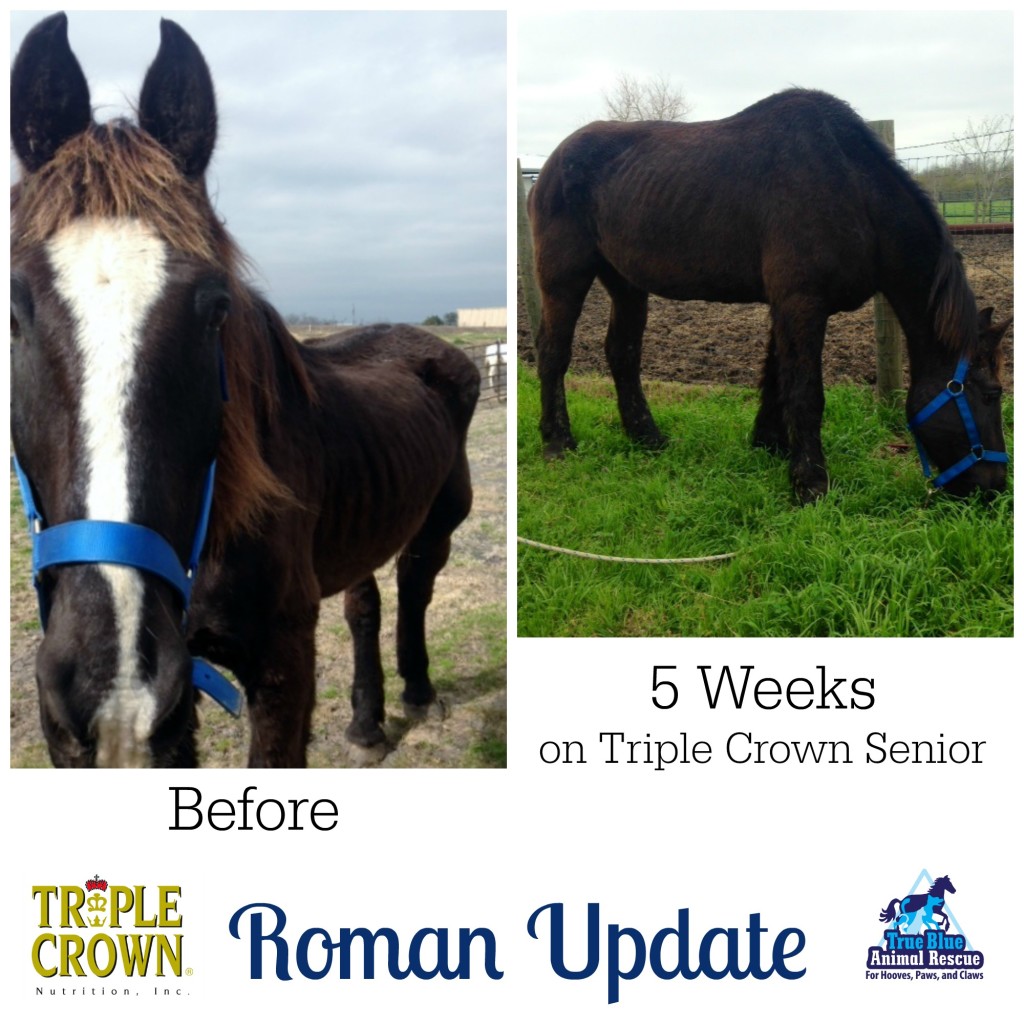 Roman is doing great on Triple Crown Senior!
Roman is doing great on Triple Crown Senior!
Roman has now been on Triple Crown Senior feed for 5 weeks now and is showing great improvement. With all of the recent rainy weather, he has enjoyed rolling and getting all muddy. His foster home is suspicious that he does it on purpose because he knows he’ll get brushed afterwards and he enjoys all of the love and attention!
Since Roman is so large, and also so malnourished, he is fed a bit more than the recommended 6 pounds of senior feed per day (half in the morning, half at night). He is benefiting from the higher nutrient content to make up for his older (and less efficient) digestive system. Triple Crown Senior has a higher fat content for extra energy, enough bulk fiber to make up for any lack of hay or grass, and it is also softer, which makes it easier on Roman’s system. In addition to his Triple Crown Senior feed, Roman is also given quality hay, access to pasture grass and clean, fresh water.
Roman is doing great, but in honor of him, and every other animal in his situation, we’d like to take a moment to explain what you need to watch out for, and what you can do to help your horse as they get older! Before Roman got to the state he was in, he could have been identified as malnourished by early weight loss, topline muscle loss, graying of the coat, and hollowing of the grooves around his eyes, as well as decreased hoof and hair coat quality. The following three things should be done for each aging horse, to ensure they have the best quality of life in their senior years.
Teeth Floating
The tool used to smooth down your horse’s teeth is a file, called a float (hence the term, teeth floating). Horse teeth never stop growing, and over time they can become sharp and uneven or fractured, making it hard for them to chew and even causing discomfort and pain. In this situation it is hard for your horse to eat feed, grass, and hay, and you may notice quids around their eating area. Quidding is when your horse tries to eat hay, but can’t properly chew and swallow it, so they essentially just wad it up in their mouth and spit it out, leaving behind quids on the ground as evidence of the teeth issues.
You can feed your senior horse a mix of senior feed and water to make a mash that is easy for them to swallow and digest while you are waiting to get their teeth floated.
Get Bloodwork done
As horses age they become at risk for metabolic issues, such as Cushings. If your horse has hormone imbalances, or organ failure, the only way to tell for sure is to get bloodwork done by your veterinarian. When you are caring for your senior pets, bloodwork is an essential step before you simply switch them to senior feed and assume all will be well.
Switch Your Horse to Senior Feed
Giving your older horse more of the same feed isn’t the answer. The feed just goes through them without the proper digestion and nutrient absorption. Proof of this can be seen if you examine your horses manure and see undigested grain.
Senior feed is softer, making it more easily digestible, and it is also specially formulated with high-quality ingredients to make up for your senior horse’s decreased ability for nutrient absorption and digestion.
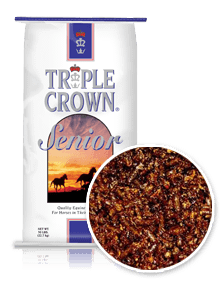
As your horse ages their bodies are less able to break down their food into the essential elements that they need for proper nutrition. Senior feed has extra high-quality vitamins and minerals, such as protein, fiber, and phosphorus, and calcium, which is easier for your senior horse’s body to process. Senior feed has high quality nutrients for better absorption, added vitamins for the immune system, and pre- and pro-biotics to help with digestive efficiency and overall health.
When is Your Horse a Senior?
Generally, 15 years and older is considered a senior horse, but it varies for each animal. The best person to advise you on what is best for your horse’s health is your veterinarian.
Diego is Home!
Last week we reported on a story of a little Chihuahua who had gotten separated from his family on their way to their new Military base posting in California. Our volunteers had networked to find his owners, and then made arrangements for him to be driven to San Diego. Today we are proud to report that not only did our community of supporters come together to raise the gas money to ensure the family did not have to contribute to Diego’s return, but Diego is now safely home and so is his transport friend, Colton!
- #Selfie! Diego meets his personal transporter, Colton!
- Road food! Diego wanted to get one last Texas Chicken Strip Basket before he leaves the state!
- Did Diego make a nest here so he could claim the big bed for himself?
- “Colton, are we there yet?”
- Finally, San Diego!
- Diego is returned to his family. You can see how happy he and his mom are to be reunited!
Thank you, Colton, for driving so far and taking such good care of Diego, and for taking the photos to share with all of us! We are so happy to share his journey, and so happy that Diego is back with his family!